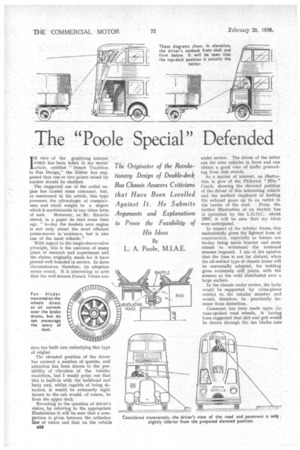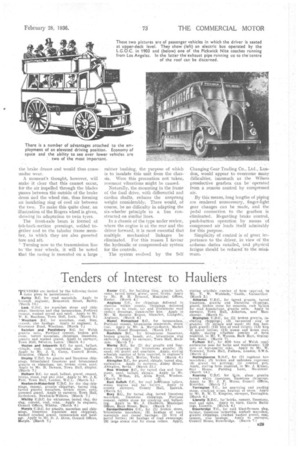e "Poole Special' Defended
Page 42

Page 43

If you've noticed an error in this article please click here to report it so we can fix it.
"N view of the gratifying interest which 'has been taken in my recent article, entitled " Desert Tradition in:.Bus Design," the Editor has suggested that one or two points raised by readers should be clarified.
The suggested use of the radial engine has caused some comment, but, as mentioned in the article, this type possesses the advantages of compactness and small weight to . a degree which is unobtainable in any Other form of unit. Moreover, as Mr. Ricardo stated, in a paper he read some time ago, "to-day the modern aero engine is not only about the most efficient prime-mover in 'existence, but is also one of the most reliable."
With regard to the single-sleeve-valve principle, this is the outcome of many years of research and experiment and the claims originally made for it have proved well founded in service. In these circumstances,therefore, its adoption seems sound. It is interesting to note that the Well-known French Voisin con
cern has built cars embodying this type of engine.
The elevated position of the driver has aroused a number of queries, and attention has been drawn to the possibility of vibration of the tubular stanchion, but I would point out that this is built-in with the bulkhead mid body and, whilst capable of being detached, it would be extremely rigid. Access to the cab would, of course, be from the upper deck.
Reverting to the question of driver's vision, by referring to the appropriate illustrations it will be seen that a comparison is given between the orthodox line of vision and that on the vehicle
under review. The driver of the latter can see over vehicles in front and can obtain a good View of traffic proceeding from side streets.
As a Matter of interest, an illustration is give of the Pickwick " Nite " Coach, showing the elevated position Of the driver of this interesting vehicle and the method employed of leading the exhaust gases up to an. outlet in the centre of the roof. . From the. further illustration of an electric bus in Operation by the L.G.O.C.about INV, • it will be seen that My ideas were anticipated.
In respect of the tubular frame, this undoubtedly gives the lightest form of construction, especially as frames are to-day being made heavier and more robust to withstand the torsional stresses imposed. I am. of the opinion that the time is not far distant, when the all-welded type of chassis frame will he universally adopted; for welding gives extremely stiff joints, with the stresses at the weld distributed over a large surface.
In the chassis under review, the body would be supported by cross-pieces welded to the tubular member and would, therefore, be practically immune from distortion.
Comment has been made upon hue vane-spoked road wheels, it having been suggested that dirt_ and grit would be drawn through the fan blades into
the brake drums and would thus cause undue wear.
A moment's thought, however, will make it clear that this cannot occur, for the air impelled through the blades passes between the outside of the brake drum and the wheel rim, thus forming an insulating ring of cool air between the two. To make this quite clear, an illustration of the Rogers wheel is given, shdwing its adaptation to twin tyres.
The front-axle beam is formed of fish-back-section -pressings, welded together and to the tubular frame member, to which they are also gusseted fore and aft.
' Turning now to the transmission line to-the -rear wheels, it will be noted that the casing is mounted on a large rubber bushing, the • purpose of which is to insulate this unit from the chas sic. Were this precaution not taken, resonant vibrations' might be caused.
Naturally, the mounting in the frame of the final drive, with differential and cardan shafts, reduces the unsprung weight considerably. There would, of course, be no difficulty in adapting the six-wheeler principle to a bus constructed on similar lines.
In a chassis of the type under review, where the engine is at the rear and the driver forward, it is most essential that multiple mechanical linkages be eliminated. For this reason I favour the hydraulic or compressed-air system for the controls.
The system evolved by the Self Changing Gear Trading Co., Ltd., London, would appear to overcome Many difficulties, inasmuch as the Wilson preselective gearbox can be operated from a remote control by compressed air. .
By this means,-long lengths of piping are rendered unnecessary, . finger-light gear changes can be made, and the pedal connection to the gearbox is eliminated. Regarding brake control. push-button operation by means of compressed air lends itself admirably for this purpose.
Simplicity of control is of great importance to the driver, in view of the arduous duties entailed, and physical fatigue should be reduced' to the minimum.




























































































